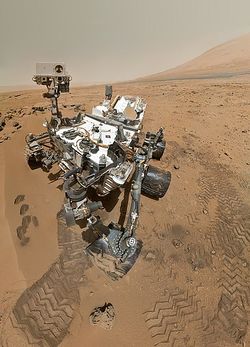Mars Science Laboratory
 From Conservapedia
From Conservapedia | Mars Science Laboratory | |
|---|---|

| |
| Self portrait of Curiosity | |
| Part of | Mars Science Laboratory |
| Launch authority | NASA |
| Control authority | JPL |
| Mission type | rover |
| Prime target | Mars |
| Launch date | November 26, 2011 |
| NSSDC ID | 1977-084A |
| Project Web site | Mars Curiosity Rover |
| Mass | 899 kg[1] |
The Mars Science Laboratory, commonly known as the Curiosity Probe, is an ongoing mission designed to last for at least 1 Martian year (667 Earth days).[2] The objectives of the Mars Science laboratory mission is to study the possibility of life on Mars now or in the past, monitoring the climate and geology, and collecting data for future manned missions to Mars. The mission was funded by the United States government via NASA, but carries an array of instruments from an international coalition.[3]
Curiosity[edit]
The probe, Curiosity is nearly twice as long as the Spirit and Opportunity rovers and weighs nearly 5 times more (900 kilograms). The probe landed in the Gale Crater, Aeolis Mons. It contains several new pieces of equipment to aid its mission. The probe also used new methods to land on Mars, including the famous "Sky-Crane". This system worked by using a rocket-powered "crane" that was designed to hover in place while the lander was lowered to its final position on the Martian surface, and was chosen because the larger rover was considered too heavy for the airbag system that had been used for previous rovers. Curiosity is equipped with a plutonium Radioisotope thermoelectric generator, which should be enough to power it for at least 10 years.
Mission objectives[edit]
The mission objectives of the MSL are simple. Determine whether Mars could have ever supported life, study the climate, and geology, and collect data for future missions to Mars. To do that, it will
- Determine the mineralogical composition of the surface and nearby structures
- Attempt to detect chemical building blocks for life
- Determine the processes that have formed the rocks and soils
- Assess longterm (4 billion years) evolution of martian atmosphere
- Assess the state and distribution of water, carbon dioxide, and how it cycles
- Characterize the broad spectrum of radiation on mars
- Part of this mission was done on the journey, while in space.
References[edit]
- ↑ Mission Timeline - NASA Mars. mars.nasa.gov. Retrieved on 2019-08-20.
- ↑ Mars Curiosity Rover - NASA Mars. marsprogram.jpl.nasa.gov. Retrieved on 2019-08-20.
- ↑ Curiosity Rover Mission Overview. mars.jpl.nasa.gov. Retrieved on 2019-08-20.
Categories: [Space Exploration]
↧ Download as ZWI file | Last modified: 03/14/2023 02:42:48 | 10 views
☰ Source: https://www.conservapedia.com/Mars_Science_Laboratory | License: CC BY-SA 3.0
 ZWI signed:
ZWI signed: KSF
KSF